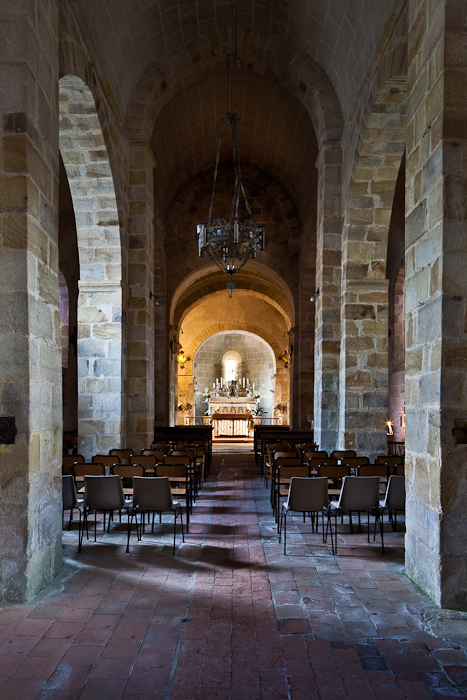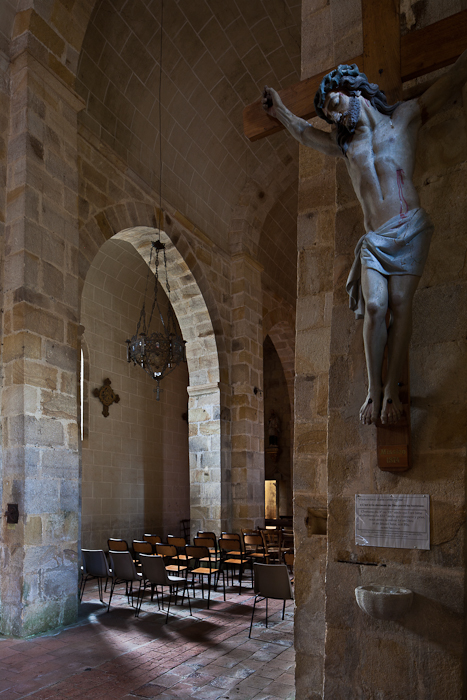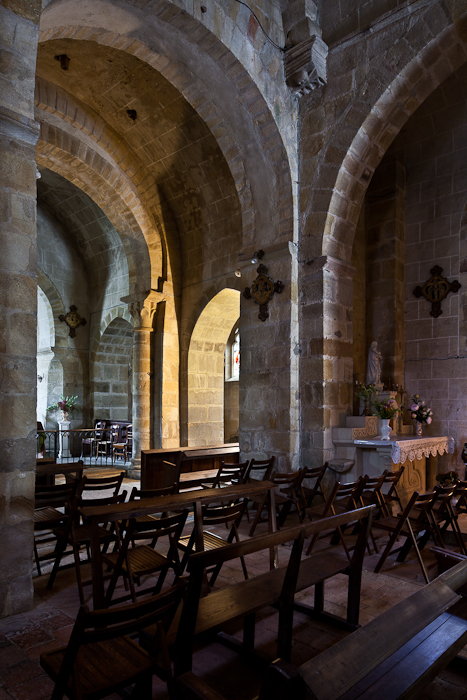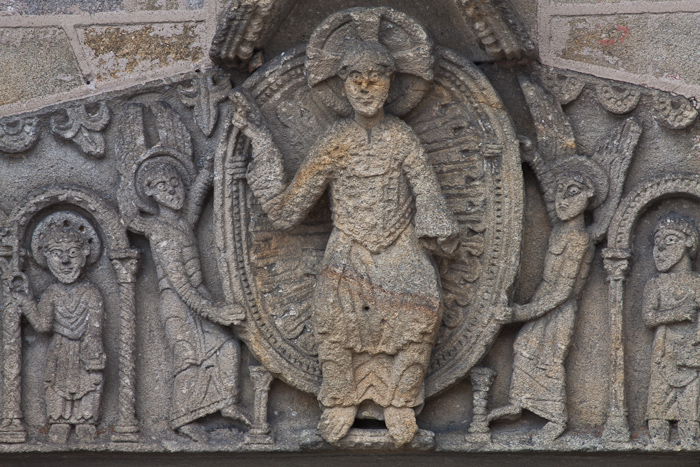PJ and I have found the Allier department, part of the Bourbonnais, to be fertile ground for Romanesque churches. One of our particular finds was in Meillers, a commune with a total population of 157. Saint Julien de Meillers was founded as a priory church and was a dependency of the diocese of Bourges and attached to the Abbey of Saint-Menoux, of which we have written before.
In this case, the church is a simple structure with three nave bays, a crossing under the tower, a short rounded apse covered with an oven vault and flanked by two 19th century side chapels.

The nave piers are solid and come to a slightly ogive point on the arcade arch. The barrel vault drops down to the top of the nave arcade. The only light comes from the windows in the side aisles. These side aisles appear to have been built later in the construction and were not originally part of the church design.
`
This simple solid structure has stood since the 12th century (it was constructed between 1180-1248). Inside, the church contains little structural decoration – a few capitals in the crossing and some small corbels decorated with figures of acrobats. One of those latter can be seen in PJ’s next shot at the intersection of the two arches.

The chapels contain mostly modern sculpture with one significant exception.

In the church is one of the oldest Vierge en majesté in the Auvergne. This 12th century wooden vierge romane is made of fruit wood and still preserves traces of the original polychrome paint. Like so many others, this statue was stolen on September 30, 2007, but recovered by the Office Central de lutte contre le trafic des Biens Culturels (OCBC), part of the Police Nationale. It was returned to the commune on June 30, 2010.

Aside from this vierge, the glory of Meillers is the west portal. There is an arch with several unadorned archivolts. There are supporting pillars on either side that have decorated capitals, and in the center, where we would normally expect to find a tympanum, there is a wonderfully sculpted lintel.

The subject is familiar; in the center Christ is depicted in a mandorla supported by two angels. On either side are five apostles, each sheltered under an arch. I have been told that Thomas and Judas are not represented here, but don’t know how that conclusion was derived.

The capitals are wonderfully inventive. On the north side of the door, there is an allegorical capital depicting an ass playing a lyre. It refers to the following fable by Phaedrus:
How Genius is often wasted through Misfortune.
An Ass espied a Lyre lying in a meadow: he approached and tried the strings with his hoof; they sounded at his touch. “By my faith, a pretty thing,” said he; “it happens unfortunately that I am not skilled in the art. If any person of greater skill had found it, he might have charmed my ears with divine notes.”
So Genius is often wasted through Misfortune.

This is a popular motif in Romanesque churches as shown in this photo of the Basilique Notre Dame de Saint-Nectaire – and poses a question to the viewer – Christianity is the lyre; are you able to bring forth the harmonies or, like the ass, be unable to play the instrument? Such is the pith of this modest priory church in the Allier. And just in case you think that we are finished using these fables as moral lessons, try this modern version!
Location: 46.506575° 3.093192°

I am glad that the statue was recovered….thefts from churches saw most of those in my locality locked except for services and in some cases valuable works removed to ‘safety’….
When I was first in France the parish church still had its 18th century gilt retable in place and displayed its silver processional cross presented by Louis XIV.
Both are now under wraps…but the old statue of St. Leonard (supposedly 12th century) still stands against the wall of the locked church, either because it is not considered of value or because any thief would risk a hernia trying to shift it.
Why does the ass and lyre motif make me think of politicians…?
Politicians, indeed. You make me laugh, Helen.
As far as the statue is concerned, so many haven’t. We’ve written before about going to the village of Thoisy-le-Désert to see the Madonna. When we found the church locked, we went to the mairie to inquire and found that it has been locked since the famous vierge was robbed a dozen years previously. The people who told us were weeping when they described the outrage, and that particular statue has never been recovered. Fortunately, the vierge noire of Saint Gervazy was recovered in Spain in an auction house!!!
You posed a question I’ve been thinking about: Can I bring forth the harmonies? It’s too hard to answer, but I clicked on your recommendation for the fable-song “Shoulda known” and now my morning is better! You come up with interesting bits and pieces, Dennis!
Trish, thanks so much for this. There is much that is wonderful in this world and it is nice to add those touches to the posts. Am very glad it made your “down under” morning better!
Dennis, Great little priory church! Was the exterior not so interesting? Have you thought about a photographic summa of your photos or a digital version sortable by date, church dedication, or region, historical ties, etc.? Your photos are of great intrinsic value as art in itself and you know about these places in depth. I know you are an artist first, but your knowledge is so valuable too. Anyway, I throw the idea out there as a distant but appreciative observer.
P.S. St. Julien was a patricidal St. and patron of pilgrims and travelers. Was this little church on a pilgrimmage route, near a significant river? The story is that he loved hunting. Returning earlier than expected he found his wife in bed with a man, quickly dispatching them with his sword. Then his wife walked in and in horror informed him that he just killed his parents. In penance he carried folks across a river for free until one day he carried a child across who blessed him and revealed he was the Christ Child and that he was forgiven. He shoulda known!
Shoulda known, indeed! I didn’t know this about Saint Julien, who is quite popular in France.
As far as your questions – the exterior is unexceptional – the 19th chapels on the north side are a bit gruesome but to tell you the truth, I spent most of my time photographing the west portal in detail. I got very few shots even inside of the church where PJ was shooting.
We do have a map-based tool on the website with about 120 churches in it. When we feature a single church, there is a link at the bottom that says “Location:” followed by the latitude/longitude. That links to a Google Maps collection of the churches we have written about. You can find all of these links in the top menu reading “Featured Churches” that breaks them down alphabetically in France, Spain, and Germany. That is our only public tool. We have a private Google Earth database that we use for research. This has about a thousand churches in France. Each entry contains the Patrimoine de France description, plus relevant quotes from Conant, Nebolsine, Editions Zodiaque, and other texts that we use for reference. They also link to photographs and articles on the web. When we plan our trips to France each year, we use this database as the basis of our travel itinerary. There is a man named Robert Consoli of Squinchpix who photographs antiquities throughout the world and who is far more diligent than we in documenting his information.
However, I have good news. A friend of mine is developing an application for investigating complex masses of material in an intuitive way – sort of semantic web application for visual data. Here are the two posts that talk about it and there are links to the demonstration. The first is here and the second here. The actual demo is in the second.
Always enjoyed the symplicity of the older churches. Our current Pope could very well work out of this one.